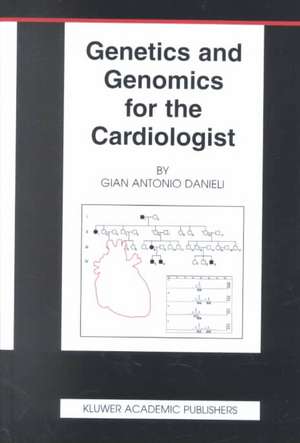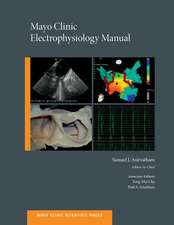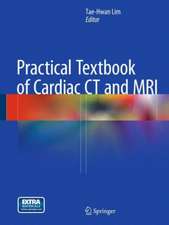Genetics and Genomics for the Cardiologist: Basic Science for the Cardiologist, cartea 14
Autor Gian Antonio Danielien Limba Engleză Hardback – 30 noi 2002
| Toate formatele și edițiile | Preț | Express |
|---|---|---|
| Paperback (1) | 712.81 lei 6-8 săpt. | |
| Springer Us – 23 oct 2012 | 712.81 lei 6-8 săpt. | |
| Hardback (1) | 720.84 lei 6-8 săpt. | |
| Springer Us – 30 noi 2002 | 720.84 lei 6-8 săpt. |
Din seria Basic Science for the Cardiologist
- 5%
 Preț: 992.14 lei
Preț: 992.14 lei - 5%
 Preț: 1101.21 lei
Preț: 1101.21 lei - 5%
 Preț: 1097.71 lei
Preț: 1097.71 lei - 5%
 Preț: 1101.21 lei
Preț: 1101.21 lei - 5%
 Preț: 1107.58 lei
Preț: 1107.58 lei - 5%
 Preț: 705.32 lei
Preț: 705.32 lei - 5%
 Preț: 1096.25 lei
Preț: 1096.25 lei - 5%
 Preț: 730.71 lei
Preț: 730.71 lei - 5%
 Preț: 374.41 lei
Preț: 374.41 lei - 5%
 Preț: 775.33 lei
Preț: 775.33 lei - 5%
 Preț: 1091.71 lei
Preț: 1091.71 lei - 5%
 Preț: 1096.81 lei
Preț: 1096.81 lei - 5%
 Preț: 1095.73 lei
Preț: 1095.73 lei - 5%
 Preț: 1421.21 lei
Preț: 1421.21 lei - 5%
 Preț: 365.82 lei
Preț: 365.82 lei - 5%
 Preț: 1103.22 lei
Preț: 1103.22 lei - 5%
 Preț: 1091.14 lei
Preț: 1091.14 lei - 5%
 Preț: 1101.94 lei
Preț: 1101.94 lei
Preț: 720.84 lei
Preț vechi: 758.77 lei
-5% Nou
Puncte Express: 1081
Preț estimativ în valută:
137.98€ • 149.92$ • 115.98£
137.98€ • 149.92$ • 115.98£
Carte tipărită la comandă
Livrare economică 22 aprilie-06 mai
Preluare comenzi: 021 569.72.76
Specificații
ISBN-13: 9781402073090
ISBN-10: 1402073097
Pagini: 244
Ilustrații: XIII, 227 p.
Dimensiuni: 155 x 235 x 19 mm
Greutate: 0.54 kg
Ediția:2002
Editura: Springer Us
Colecția Springer
Seria Basic Science for the Cardiologist
Locul publicării:New York, NY, United States
ISBN-10: 1402073097
Pagini: 244
Ilustrații: XIII, 227 p.
Dimensiuni: 155 x 235 x 19 mm
Greutate: 0.54 kg
Ediția:2002
Editura: Springer Us
Colecția Springer
Seria Basic Science for the Cardiologist
Locul publicării:New York, NY, United States
Public țintă
ResearchCuprins
1: The Human Genome.- 1.1 Size and characteristics of nuclear and mitochondrial genome in humans.- 1.2 Structural and functional organization of human chromosomes.- 1.3 Structural and functional organization of human genes.- 1.4 Artificial banding of human chromosomes.- 1.5 Replication of human DNA and the origin of new mutations.- 1.6 Effects of mutations in DNA sequences.- 1.7 DNA markers.- 1.8 Chromosomal basis of inheritance.- 1.9 The main reference database for human disease genes.- 1.10 The Human Mutation Database and the nomenclature for human mutations.- 2: From Genome to Clinical Phenotype.- 2.1 Analyzing the human transcriptome.- 2.2 The differential expression of human genes.- 2.3 From transcriptome to proteome and metabolome.- 2.4 The transcriptome of the human heart.- 2.5 Genotype and phenotype.- 2.6 Molecular explanation of dominance of some mutations.- 2.7 Gene dosage.- 2.8 Peculiarity of phenotypes due to mutations in mitochondrial DNA.- 2.9 Multi-factorial diseases.- 3: Identifying Disease Genes in Humans.- 3.1 Starting with the family.- 3.2 The positional candidate gene approach.- 3.3 Linkage analysis in Mendelian diseases.- 3.4 Linkage analysis in multifactorial diseases.- 3.5 Detecting pathogenic mutations.- 3.6 Establishing the pathogenic role of specific mutations.- 3.7 Establishing genotype-phenotype correlations.- 4: Inherited Structural and Functional Defects of Myocardium.- 4.1 Cardiomyopathies.- 4.2 Genetic heterogeneity of cardiomyopathies and the “final common pathway” hypothesis.- 4.3 Arrhythmic disorders.- 4.4 Genetic basis of congenital heart defects in humans.- 4.5 Transgenic animals and the genetic dissection of developmental phenotypes.- 4.6 Understanding cardiovascular development.- 5: Inherited Cardiovascular Disorders.- 5.1Structural defects of vessels.- 5.2 Coronary atherosclerosis and myocardial infarction.- 5.3 Genetics of hypertension.- 5.4 Understanding hypertension through animal models.- 6: Genetics and Genomics Applied to Diagnosis and Therapy.- 6.1 Growing interest for genetic tests.- 6.2 Purposes and methods of genetic testing.- 6.3 Novel genetic tests.- 6.4 Genetic risk assessment.- 6.5 Genetic tests: some ethical and legal aspects.- 6.6 Genetics and genomics applied to drug therapy: pharmacogenetics and pharmacogenomics.- 6.7 Pharmacogenetics in Cardiology.- 6.8 Pharmacogenomics and beyond.- 6.9 Gene-based therapeutics.- Conclusion.- References.- Appendix I: Updated information from the Web.- Appendix II: OMIM IDs for monogenic disorders relevant to Cardiology.- Appendix III: Genes encoding ionic channels and expressed in human heart.- Credits.




